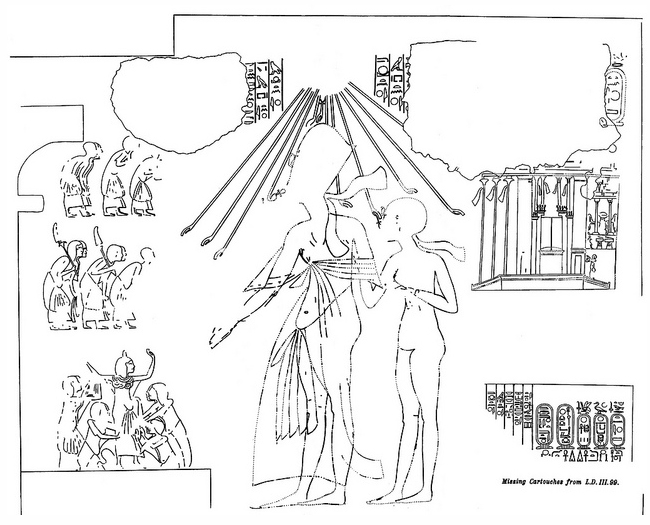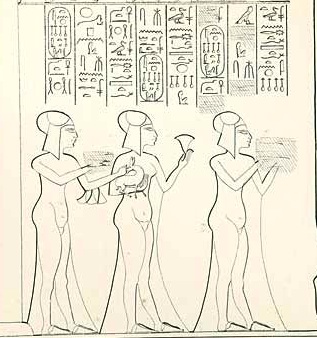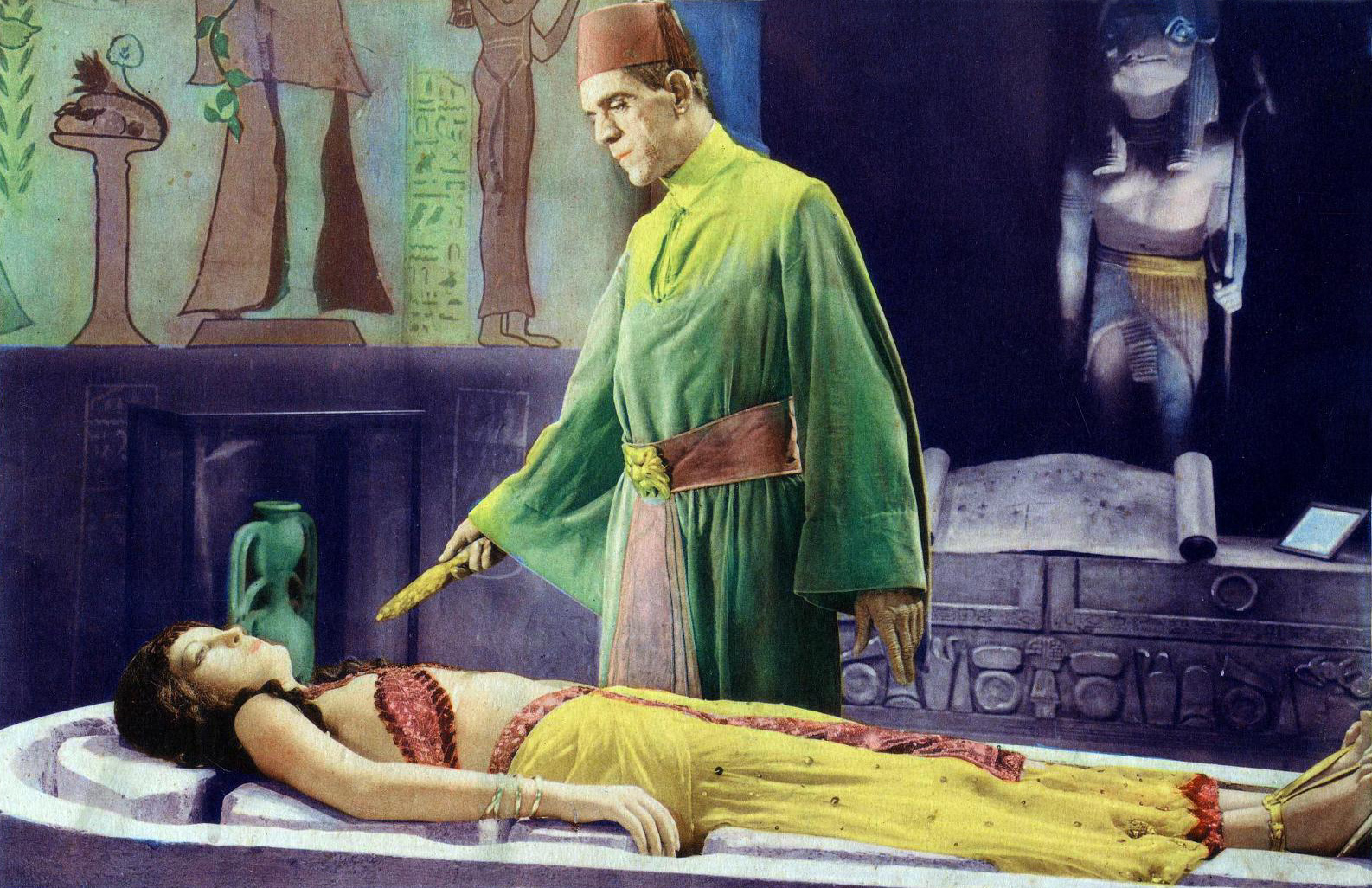|
Meryre II
Meryre II was an ancient Egyptian noble known as the superintendent of Queen Nefertiti, and held the title of royal scribe, steward, overseer of the two treasuries, overseer of the royal harem of Nefertiti. He had a tomb constructed at Amarna, although his remains have never been identified. The tomb has the last dated appearance of Akhenaten and the Amarna family. Tomb of Meryra II The tomb of Meryra II is the royal sepulcher known as Amarna Tomb 2. The tomb dates back to the 18th Dynasty.Davies, Norman de Garis. The Rock Tombs of El Amarna. Part II – The Tomb of Panehesy and Meryra II. London, 1905. Facsimile iInternet Archive Egypt Exploration Society (2004) It is located in the northern side of the wadi that splits the cluster of tombs known collectively as the Northern tombs, near to the city of Amarna, Egypt. The tomb has been largely destroyed. It was decorated with the last dated appearance of Akhenaten and the Amarna family, dating from the second month, y ... [...More Info...] [...Related Items...] OR: [Wikipedia] [Google] [Baidu] |
Smenkhare
Smenkhkare (alternatively romanized ''Smenkhare'', ''Smenkare,'' or ''Smenkhkara''; meaning "'Vigorous is the Soul of Re") was an ancient Egyptian pharaoh of unknown background who lived and ruled during the Amarna Period of the 18th Dynasty. Smenkhkare was husband to Meritaten, the daughter of his likely co-regent, Akhenaten. Very little is known of Smenkhkare for certain because later kings sought to erase the Amarna Period from history. Because of this, perhaps no one from the Amarna Interlude has been the subject of so much speculation as Smenkhkare. Origin and family Smenkhkare's origins are unknown. It is assumed he was a member of the royal family, likely either a brother or son of the pharaoh Akhenaten. If he is Akhenaten's brother, his mother was likely either Tiye or Sitamun. If a son of Akhenaten, he was presumably an older brother of Tutankhamun, as he succeeded the throne ahead of him; his mother was likely an unknown, lesser wife. An alternative suggestion, base ... [...More Info...] [...Related Items...] OR: [Wikipedia] [Google] [Baidu] |
Nefertiti
Neferneferuaten Nefertiti () ( – c. 1330 BC) was a queen of the 18th Dynasty of Ancient Egypt, the great royal wife of Pharaoh Akhenaten. Nefertiti and her husband were known for a radical change in national religious policy, in which they promoted a form of proto-monotheism centred on the sun god Aten. With her husband, she reigned at what was arguably the wealthiest period of ancient Egyptian history. Some scholars believe that Nefertiti ruled briefly as Neferneferuaten after her husband's death and before the ascension of Tutankhamun, although this identification is a matter of ongoing debate.Dodson, Aidan, Amarna Sunset: ''Nefertiti, Tutankhamun, Ay, Horemheb, and the Egyptian Counter-Reformation''. The American University in Cairo Press. 2009, . If Nefertiti did rule as Pharaoh, her reign was marked by the fall of Amarna and relocation of the capital back to the traditional city of Thebes. She was made famous by her bust, now in Berlin's Neues Museum. The bu ... [...More Info...] [...Related Items...] OR: [Wikipedia] [Google] [Baidu] |
Meryre (given Name)
Meryre or Meryra (“Beloved of Ra”) was an ancient Egyptian male name, occurring both as a personal and as a throne name. A variant is ''Merenre,'' the female version is '' Merytre.'' Famous bearers were: As a personal name * Meryre, treasurer under Amenhotep III, tutor of Prince Siatum (18th dynasty) * Meryre, High Priest of Aten (18th dynasty) * Meryre, steward of the royal harem in Amarna (18th dynasty) * Meryre, a son of Ramesses II and Nefertari, 11th on the list of princes * Meryre, another son of Ramesses II, possibly named after the first Meryre; 18th on the list of princesDodson&Hilton, pp.165,172 As a throne name * Pepi I ''(Meryre)'' * Nemtyemsaf I ''(Merenre)'' * Nemtyemsaf II Merenre Nemtyemsaf II was an ancient Egyptian pharaoh, the sixth and penultimate ruler of the 6th Dynasty. He reigned for 1 year and 1 month in the first half of the 22nd century BC, at the very end of the Old Kingdom period. Nemtyemsaf II likel ... ''(Merenre)'' Sources {{given ... [...More Info...] [...Related Items...] OR: [Wikipedia] [Google] [Baidu] |
Meryre (treasurer)
Meryre was an ancient Egyptian official under king Amenhotep III in the 18th Dynasty around 1375 BC. His main title was treasurer. He was therefore one of the most important officials at the royal court, looking after the belongings of the king and the goods of the palace. Meryre is so far only attested in his tomb at Saqqara, that was discovered in the 1980s in the temple area known as the Bubasteum. The tomb is decorated with reliefs. Some of them were already early on cut out of the walls and sold on the art market. Two of these reliefs are now in Vienna ( Kunsthistorisches Museum). Old drawings show that they were once in a much better condition.Betsy M. Bryan: ''Tomb Relief of Chancellor Meryra and Lady Baketamun'', and ''Tomb Reliefs of Meryra and Baketamun before the Gods Osiris and Ra-Horachte'', in: Arielle P. Kozloff, Betsy M. Bryan, Lawrence M. Berman: ''Egypt's Dazzling Sun. Amenhotep III and his World''. Cleveland Museum of Art, Cleveland 1992, , pp. 292–294, nos. ... [...More Info...] [...Related Items...] OR: [Wikipedia] [Google] [Baidu] |
Great Royal Wife
Great Royal Wife, or alternatively, Chief King's Wife ( Ancient Egyptian: ''ḥmt nswt wrt'', cop, Ⲟⲩⲏⲣ Ⲟⲩⲣϣ), is the title that was used to refer to the principal wife of the pharaoh of Ancient Egypt, who served many official functions. Description While most ancient Egyptians were monogamous, a male pharaoh would have had other, lesser wives and concubines in addition to the Great Royal Wife. This arrangement would allow the pharaoh to enter into diplomatic marriages with the daughters of allies, as was the custom of ancient kings. In the past the order of succession in Ancient Egypt was thought to pass through the royal women. This theory, referred to as the Heiress Theory, has been rejected regarding the Eighteenth Dynasty ever since a 1980s study of its royalty.O'Connor and Cline (Editors), Amenhotep III: Perspectives on his reign, pg 6 The throne likely passed to the eldest living son of those pharaohs. The mother of the heir to the throne was not alway ... [...More Info...] [...Related Items...] OR: [Wikipedia] [Google] [Baidu] |
Setepenre
Setepenre is an often-used title of Egyptian kings (pharaohs), meaning "Elect of Re". It was also used as a personal name in at least two instances. Pronunciation In Akkadian records, the name (referring to Ramesses II) is rendered in cuneiform script as šá-te-ep-na-ri/e-a. According to the Egyptologist Antonio Loprieno, the word was likely pronounced {{lang, egy, /satʰepʰna'riːʕa/.Loprieno, Antonio (1995), ''Ancient Egyptian - A linguistic introduction'', Oxford University Press, p. 29 As a personal name * Setepenre, last daughter of Akhenaten and Nefertiti ( 18th Dynasty) * Setepenre, a son of Ramesses II ( 19th Dynasty) As a throne name * Usermaatre Setepenre (Ramesses II) * Userkheperure Setepenre (Seti II) * Akhenre Setepenre (Siptah) * Usermaatre Setepenre (Ramesses VII) * Neferkare Setepenre Khaemwaset (Ramesses IX) * Khepermaatre Setepenre (Ramesses X) * Hedjkheperre Setepenre (Smendes I) * Aakheperre Setepenre ( Osorkon the Elder) * Netjerkheperre Setepenre (Sia ... [...More Info...] [...Related Items...] OR: [Wikipedia] [Google] [Baidu] |
Season Of The Emergence
The Season of the Emergence ( egy, Prt) was the second season of the lunar and civil Egyptian calendars. It fell after the Season of the Inundation (') and before the Season of the Harvest ('). In the modern Coptic calendar, the season falls between Paopi 10 and Tobi 10. Names The pronunciation of the Ancient Egyptian name for the Season of the Emergence is uncertain as the hieroglyphs do not record its vowels. It is conventionally transliterated Peret or Proyet. The name refers to the emergence of the fertile land beside the Nile from its annual flood and to the growth of vegetation and crops over the following season. It is also known as Winter. Lunar calendar In the lunar calendar, the intercalary month was added as needed to maintain the heliacal rising of Sirius in the fourth month of the Season of the Harvest. This meant that the Season of the Emergence usually lasted from January to May. Because the precise timing of the flood varied, the months of "Emergence" ... [...More Info...] [...Related Items...] OR: [Wikipedia] [Google] [Baidu] |
Foreign Tributes
Foreign may refer to: Government * Foreign policy, how a country interacts with other countries * Ministry of Foreign Affairs, in many countries ** Foreign Office, a department of the UK government ** Foreign office and foreign minister * United States state law, a legal matter in another state Science and technology * Foreign accent syndrome, a side effect of severe brain injury * Foreign key, a constraint in a relational database Arts and entertainment * Foreign film or world cinema, films and film industries of non-English-speaking countries * Foreign music or world music * Foreign literature or world literature * '' Foreign Policy'', a magazine Music * "Foreign", a song by Jessica Mauboy from her 2010 album '' Get 'Em Girls'' * "Foreign" (Trey Songz song), 2014 * "Foreign", a song by Lil Pump from the album ''Lil Pump'' Other uses * Foreign corporation, a corporation that can do business outside its jurisdiction * Foreign language, a language not spoken by the peo ... [...More Info...] [...Related Items...] OR: [Wikipedia] [Google] [Baidu] |
Neferneferure
Neferneferure ( egy, nfr-nfr.w-rꜥ "beautiful are the beauties of Re") (14th century BCE) was an ancient Egyptian princess of the 18th Dynasty. She was the fifth of six known daughters of Pharaoh Akhenaten and his Great Royal Wife Nefertiti. Family Neferneferure was born in or before the 8th regnal year of her father Akhenaten in the city of Akhetaten.Tyldesley, Joyce. Nefertiti: Egypt's Sun Queen. Penguin. 1998. She had four older sisters named Meritaten, Meketaten, Ankhesenpaaten and Neferneferuaten Tasherit, as well as a younger sister named Setepenre.Dodson, Aidan and Hilton, Dyan. The Complete Royal Families of Ancient Egypt. Thames & Hudson. 2004. Life One of the earliest depictions of Neferneferure is in a fresco from the King's House in Amarna. She is depicted sitting on a pillow with her sister Neferneferuaten Tasherit. The fresco is dated to ca. year 9 of Akhenaten, and the entire family is depicted, including the baby Setepenre. Neferneferure is depicted at ... [...More Info...] [...Related Items...] OR: [Wikipedia] [Google] [Baidu] |
Neferneferuaten Tasherit
Neferneferuaten Tasherit or Neferneferuaten the younger (14th century BCE) was an ancient Egyptian princess of the 18th Dynasty and the fourth daughter of Pharaoh Akhenaten and his Great Royal Wife Nefertiti. Family Neferneferuaten was born between ca. year 8 and 9 of her father's reign. She was the fourth of six known daughters of the royal couple. It is likely that she was born in Akhetaten, the capital founded by her father. Her name ''Neferneferuaten'' ("Beauty of the Beauties of Aten" or "Most Beautiful One of Aten") is the exact copy of the name Nefertiti took in the 5th regnal year. ("Ta-sherit" simply means "the younger").Tyldesley, Joyce. Nefertiti: Egypt's Sun Queen. Penguin. 1998. She had three older sisters named Meritaten, Meketaten, and Ankhesenpaaten (later known as Ankhesenamun), and two younger sisters named Neferneferure and Setepenre.Dodson, Aidan and Hilton, Dyan. The Complete Royal Families of Ancient Egypt. Thames & Hudson. 2004. Life One of the ea ... [...More Info...] [...Related Items...] OR: [Wikipedia] [Google] [Baidu] |
Ankhesenpaaten
Ankhesenamun (, "Her Life Is of Amun"; c. 1348 or c. 1342 – after 1322 BC) was a queen who lived during the 18th Dynasty of Egypt as the pharaoh Akhenaten's daughter and subsequently became the Great Royal Wife of pharaoh Tutankhamun. Born Ankhesenpaaten (, "she lives for the Aten"), she was the third of six known daughters of the Egyptian Pharaoh Akhenaten and his Great Royal Wife Nefertiti. She became the Great Royal Wife of Tutankhamun. The change in her name reflects the changes in ancient Egyptian religion during her lifetime after her father's death. Her youth is well documented in the ancient reliefs and paintings of the reign of her parents. The mummy of Tutankhamun's mother has been identified through DNA analysis as a full sister to his father, the unidentified mummy found in tomb KV55, and as a daughter of his grandfather, Amenhotep III. So far his mother's name is uncertain, but her mummy is known informally to scientists as the Younger Lady. Ankhesenamun was well ... [...More Info...] [...Related Items...] OR: [Wikipedia] [Google] [Baidu] |
Meketaten
Meketaten ("Behold the Aten" or "Protected by Aten") was the second daughter of six born to the Egyptian Pharaoh Akhenaten and his Great Royal Wife Nefertiti. She likely lived between Year 4 and Year 14 of Akhenaten's reign. Although little is known about her, she is frequently depicted with her sisters accompanying her royal parents in the first two-thirds of the Amarna Period. Biography Meketaten was born approximately in Year 4 of Akhenaten's reign to that pharaoh and his Great Royal Wife, Nefertiti.Tyldesley, Joyce. Nefertiti: Egypt's Sun Queen. Penguin. 1998. She had an elder sister, Meritaten, and four younger sisters: Ankhesenpaaten, Neferneferuaten Tasherit, Neferneferure and Setepenre. Tutankhaten was likely a full or half-brother through their father. Her birth year is estimated based on the dates of inscriptions that reference her. The first known depiction of Meketaten is on the walls of the ''Hwt-benben'' temple in Thebes, which is dedicated to her mother Nefertiti. ... [...More Info...] [...Related Items...] OR: [Wikipedia] [Google] [Baidu] |








